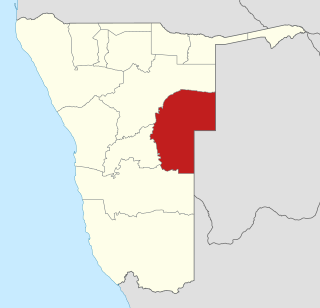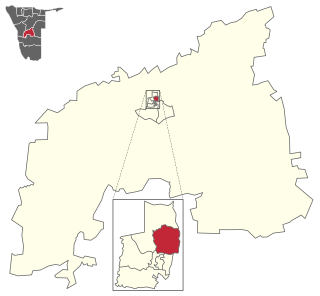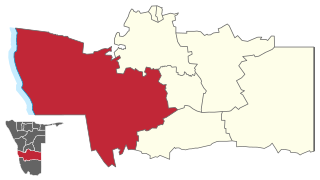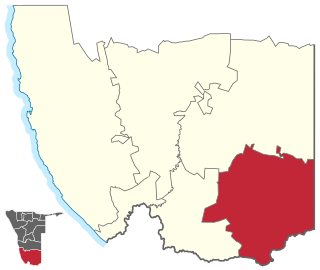
Khomas is one of the fourteen regions of Namibia. Its name refers to the Khomas Highland, a high plateau landscape that dominates this administrative unit. Khomas is centered on the capital city Windhoek and provides for this reason superior transportation infrastructure. It is located in the central highlands of the country and is bordered by the Erongo region to the west and the northwest and by the Otjozondjupa region to the north. To the east is the Omaheke region, while in the south is the Hardap region. The region is characterized by its hilly countrysize and many valleys. It has well-developed economical, financial, and trade sectors. Khomas Region occupies 4.5% of the land area of Namibia but has the highest population of any of its regions (16.2%). Khomas is one of only three Namibian regions to have neither shoreline nor a foreign border.

Omaheke is one of the fourteen regions of Namibia, the least populous region. Its capital is Gobabis. It lies in eastern Namibia on the border with Botswana and is the western extension of the Kalahari desert. The self-governed villages of Otjinene, Leonardville and Witvlei are situated in the region. As of 2020, Omaheke had 48,594 registered voters.

Katutura Central is a constituency in the Khomas Region of Namibia, comprising the extensions 2–5 and 7–11 of Windhoek's suburb Katutura. Katutura is a township that was founded by the then apartheid government of Namibia for black people in the 1950s, when the previous township, Old Location, was converted into the suburb Hochland Park.

Khomasdal North is a constituency in Windhoek in the Khomas Region of Namibia. As of December 2019 it had 25,550 registered voters. The constituency consists of parts of the suburbs Khomasdal, Katutura, and Otjomuise. It had a population of 43,921 in 2011, up from 27,950 in 2001.

John Pandeni constituency, formerly known as Soweto is a constituency in the Khomas Region of Namibia. In 2008, it was renamed after John Pandeni, a member of the South West Africa People's Organization (SWAPO) and its militant wing, the People's Liberation Army of Namibia (PLAN). Pandeni was the first regional councilor for the former Soweto constituency and the first governor of Khomas. This constituency is inside the city of Windhoek in the formerly all-Black suburb of Katutura. It had a population of 15,121 in 2011, up from 13,865 in 2001. As of 2020, it has 14,758 registered voters.

Tobias Hainyeko constituency is an electoral constituency in Windhoek, the capital of Namibia. It had a population of 45,912 in 2011, up from 34,348 in 2001. As of 2020 it had 36,530 registered voters.

Mpungu is a constituency in the Kavango West region of Namibia. It had a population of 20,787 in 2011, up from 18,660 in 2001, and 9,121 registered voters in 2020, up from 8,924 in 2004.

Kapako is a constituency in the Kavango West region of Namibia. The district centre is the settlement of Kapako. It had a population of 26,983 in 2011, up from 26,263 in 2001.

Windhoek West Constituency is an electoral constituency in the Khomas Region of Namibia. It contains the affluent suburbs of Hochland Park, Pioneers Park, Academia, Cimbebasia, Rocky Crest, Windhoek North and Windhoek West. It had a population of 53,438 in 2011, up from 42,201 in 2001. As of 2020, it has 33,556 registered voters.

Moses ǁGaroëb Constituency is an electoral constituency in Windhoek, the capital of Namibia. It had a population of 45,564 in 2011, up from 25,642 in 2001. As of 2020 it had 41,550 registered voters.

Rundu Urban is an electoral constituency in the Kavango East region of Namibia. It covers the urban area of Rundu, the region's capital and one of Namibia's largest cities. The constituency also covers parts of the Sauyemwa, Safari, Tutungeni, Katutura, Donkerhoek and Kehemu neighborhoods. It had a population of 20,953 in 2011, up from 19,173 in 2001. As of 2020 the constituency had 35,740 registered voters.

Opuwo Rural is an electoral constituency in the Kunene Region of Namibia. The administrative centre of Opuwo Rural is the settlement of Otuani. As of 2020, it has 7,315 registered voters.

Oshikunde Constituency is an electoral constituency in the Ohangwena Region of Namibia. As of 2020, it has 8,062 registered voters.

Judea Lyaboloma Constituency is an Electoral district in Namibia. It is situated in the Zambezi Region. Its centre is Sangwali which is a settlement 129.3 kilometres out of Katima Mulilo. The constituency has a population of 5,511 people. In the 2020 Regional Council Elections, there were 3,339 registered voters.

Daweb Constituency is an electoral constituency in the Hardap Region of Namibia. It was created in August 2013, following a recommendation of the Fourth Delimitation Commission of Namibia, and in preparation of the 2014 general election. Daweb constituency was formed from the western part of Gibeon Constituency.

Mankumpi Constituency is an electoral constituency in the Kavango West Region of Namibia. The administrative centre is the village of Satotwa. Mankumpi was created in August 2013, following a recommendation of the Fourth Delimitation Commission of Namibia, and in preparation of the 2014 general election. It was formed from the south-eastern part of the former Kahenge Constituency.

Ncamagoro Constituency is an electoral constituency in the Kavango West Region of Namibia. As of 2020 the constituency had 6,494 registered voters.

Karasburg East is an electoral constituency in the ǁKaras Region of Namibia. As of 2020 the constituency had 6,553 registered voters.

Ncuncuni is a constituency in the Kavango West region of Namibia. It is located west of Rundu, one of Namibia's largest cities. It had a population of 38,281 in 2011, up from 26,623 in 2001. As of 2020 the constituency had 4,554 registered voters.

Opuwo Urban is a constituency in the Kunene Region of Namibia. It comprises the townlands of Opuwo, which is also its administrative centre. As of 2020, it has 10,590 registered voters.































